Intel's Pentium M on the Desktop - A Viable Alternative?
by Anand Lal Shimpi on February 7, 2005 4:00 PM EST- Posted in
- CPUs
Workstation Applications
Visual Studio 6
Carried over from our previous CPU reviews, we continue to use Visual Studio 6 for a quick compile test. We are still using the Quake 3 source code as our test and measure compile time in seconds.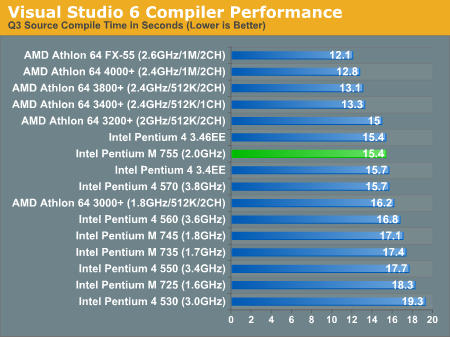
The Pentium M is very competitive with the Pentium 4 in our compiler test, but still not enough to compete with the Athlon 64.
SPECviewperf 8
For our next set of professional application benchmarks, we turn to SPECviewperf 8. SPECviewperf is a collection of application traces taken from some of the most popular professional applications, and compiled together in a single set of benchmarks used to estimate performance in the various applications that the benchmark is used to model. With version 8, SPEC has significantly improved the quality of the benchmark, making it even more of a real world indicator of performance.We have included SPEC's official description of each one of the 8 tests in the suite.
As you can guess, with the majority of performance in 3D workstation applications being determined by floating point performance and memory bandwidth, the Pentium M doesn't fare too well:
3dsmax Viewset (3dsmax-03)
"The 3dsmax-03 viewset was created from traces of the graphics workload generated by 3ds max 3.1. To ensure a common comparison point, the OpenGL plug-in driver from Discreet was used during tracing.
The models for this viewset came from the SPECapc 3ds max 3.1 benchmark. Each model was measured with two different lighting models to reflect a range of potential 3ds max users. The high-complexity model uses five to seven positional lights as defined by the SPECapc benchmark and reflects how a high-end user would work with 3ds max. The medium-complexity lighting models use two positional lights, a more common lighting environment.
The viewset is based on a trace of the running application and includes all the state changes found during normal 3ds max operation. Immediate-mode OpenGL calls are used to transfer data to the graphics subsystem."
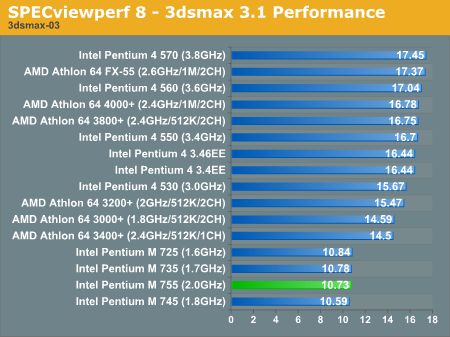
CATIA Viewset (catia-01)
"The catia-01 viewset was created from traces of the graphics workload generated by the CATIATM V5R12 application from Dassault Systems.
Three models are measured using various modes in CATIA. Phil Harris of LionHeart Solutions, developer of CATBench2003, supplied SPEC/GPC with the models used to measure the CATIA application. The models are courtesy of CATBench2003 and CATIA Community.
The car model contains more than two million points. SPECviewperf replicates the geometry represented by the smaller engine block and submarine models to increase complexity and decrease frame rates. After replication, these models contain 1.2 million vertices (engine block) and 1.8 million vertices (submarine).
State changes as made by the application are included throughout the rendering of the model, including matrix, material, light and line-stipple changes. All state changes are derived from a trace of the running application. The state changes put considerably more stress on graphics subsystems than the simple geometry dumps found in older SPECviewperf viewsets.
Mirroring the application, draw arrays are used for some tests and immediate mode used for others."
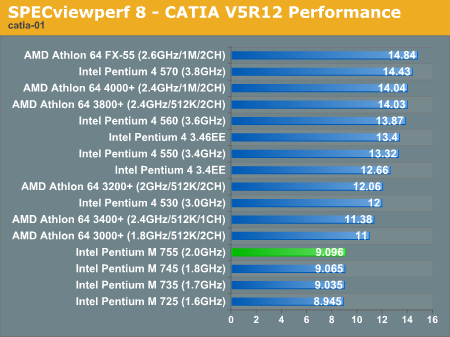
Lightscape Viewset (light-07)
"The light-07 viewset was created from traces of the graphics workload generated by the Lightscape Visualization System from Discreet Logic. Lightscape combines proprietary radiosity algorithms with a physically based lighting interface.
The most significant feature of Lightscape is its ability to simulate global illumination effects accurately by precalculating the diffuse energy distribution in an environment and storing the lighting distribution as part of the 3D model. The resulting lighting "mesh" can then be rapidly displayed."
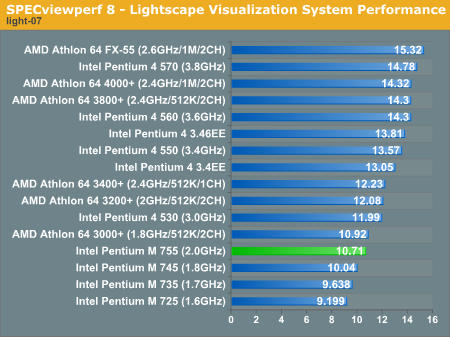
Maya Viewset (maya-01)
"The maya-01 viewset was created from traces of the graphics workload generated by the Maya V5 application from Alias.
The models used in the tests were contributed by artists at NVIDIA. Various modes in the Maya application are measured.
State changes as made by the application are included throughout the rendering of the model, including matrix, material, light and line-stipple changes. All state changes are derived from a trace of the running application. The state changes put considerably more stress on graphics subsystems than the simple geometry dumps found in older viewsets.
As in the Maya V5 application, array element is used to transfer data through the OpenGL API."
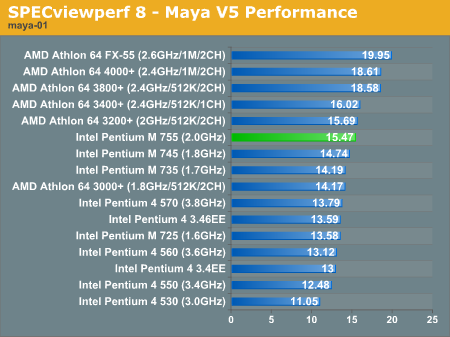
Pro/ENGINEER (proe-03)
"The proe-03 viewset was created from traces of the graphics workload generated by the Pro/ENGINEER 2001TM application from PTC.
Two models and three rendering modes are measured during the test. PTC contributed the models to SPEC for use in measurement of the Pro/ENGINEER application. The first of the models, the PTC World Car, represents a large-model workload composed of 3.9 to 5.9 million vertices. This model is measured in shaded, hidden-line removal, and wireframe modes. The wireframe workloads are measured both in normal and antialiased mode. The second model is a copier. It is a medium-sized model made up of 485,000 to 1.6 million vertices. Shaded and hidden-line-removal modes were measured for this model.
This viewset includes state changes as made by the application throughout the rendering of the model, including matrix, material, light and line-stipple changes. The PTC World Car shaded frames include more than 100MB of state and vertex information per frame. All state changes are derived from a trace of the running application. The state changes put considerably more stress on graphics subsystems than the simple geometry dumps found in older viewsets.
Mirroring the application, draw arrays are used for the shaded tests and immediate mode is used for the wireframe. The gradient background used by the Pro/E application is also included to better model the application workload."

SolidWorks Viewset (sw-01)
"The sw-01 viewset was created from traces of the graphics workload generated by the Solidworks 2004 application from Dassault Systemes.
The model and workloads used were contributed by Solidworks as part of the SPECapc for SolidWorks 2004 benchmark.
State changes as made by the application are included throughout the rendering of the model, including matrix, material, light and line-stipple changes. All state changes are derived from a trace of the running application. The state changes put considerably more stress on graphics subsystems than the simple geometry dumps found in older viewsets.
Mirroring the application, draw arrays are used for some tests and immediate mode used for others."

Unigraphics (ugs-04)
"The ugs-04 viewset was created from traces of the graphics workload generated by Unigraphics V17.
The engine model used was taken from the SPECapc for Unigraphics V17 application benchmark. Three rendering modes are measured -- shaded, shaded with transparency, and wireframe. The wireframe workloads are measured both in normal and anti-alised mode. All tests are repeated twice, rotating once in the center of the screen and then moving about the frame to measure clipping performance.
The viewset is based on a trace of the running application and includes all the state changes found during normal Unigraphics operation. As with the application, OpenGL display lists are used to transfer data to the graphics subsystem. Thousands of display lists of varying sizes go into generating each frame of the model.
To increase model size and complexity, SPECviewperf 8.0 replicates the model two times more than the previous ugs-03 test."
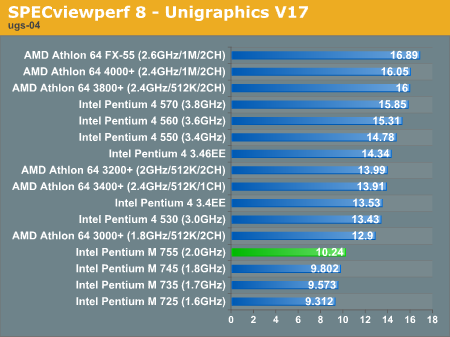










77 Comments
View All Comments
bob661 - Tuesday, February 8, 2005 - link
The only problem with this chip is that the marketing is oriented towards the mobile market and therefore not a direct competitor to the A64. It would be nice if it was. It might bring some cats out of the bag on the AMD side. Competition in the marketplace is good for us all.jvrobert - Tuesday, February 8, 2005 - link
Really, AMDroids, get a grip. You're all excited because the AMD chips beat a mobile processor pretty handily, and because you are making some silly assumption that the Pentium-M in its current form is Intel's "last chance".First, Intel doesn't need a last chance. They make enough money to make AMD look like a Mexico City taco stand. So enough of those delusions of grandeur.
But on a technical front, if Intel ramps the clockspeed up to the 2.8 range (easy), and releases a desktop class chipset for the Pentium M it would match or exceed any current chip. And these are _basic_ steps. What if they made more improvements?
jvrobert - Tuesday, February 8, 2005 - link
bob661 - Tuesday, February 8, 2005 - link
#45You are a rock. The point of the article was to compare the P-M to desktop CPU's because most of us here wanted to know it will perform. And you know what? It performed very nicely.
classy - Tuesday, February 8, 2005 - link
I just can't help but to laugh at some folks. Its a nice chip but clearly not in the A64 ballpark. Its that simple. As far as the 2.8 oc, that was only accomplished in one reveiw. All the reviews show the same thing you have oc so it can it compete. What's interesting though is most of these Intel fanboys don't want to see a comparison of an oc'ed A64 vs a Dothan. Smoke city :)FrostAWOL - Tuesday, February 8, 2005 - link
IF the Pentium-M and P4 are electrically incompatible then someone please explain this:HP Blade system Pentium-M with Serverworks GC-SL chipset
http://h18000.www1.hp.com/products/servers/prolian...
FrostAWOL
jae63 - Tuesday, February 8, 2005 - link
Great review & of interest to those of us with HTPCs. Too bad the price point is so steep.One minor correction on page 11:
"The Pentium M does a bit better in the document creation tests, as they are mostly using applications that will fit within the CPU's cache. However, the introduction of a voice recognition program into the test stresses the Pentium M's floating point performance, which does hamper its abilities here."
Actually NaturallySpeaking uses almost no floating point but is very memory intensive. The performance hit that you are seeing is because it uses a lot of memory bandwidth and its dataset doesn't fit in the L2 cache.
Here's some support for my statement, by the main architect of NaturallySpeaking, Joel Gould:
http://tinyurl.com/6s4mh
segagenesis - Tuesday, February 8, 2005 - link
#43 - I think you have the right idea here. This processor is not meant to be performance busting but rather a low energy alternative to current heat factories present inside every P4 machine. I would love to have this in a HTPC machine myself but the cost is still too damn high. Hopefully higher production will bring the cost down.Aileur - Tuesday, February 8, 2005 - link
I guess the pentium M isnt ready (yet) for a full featured gaming machine, but with that kind of power, passively cooled, it would make for one hell of an htpc.PrinceGaz - Tuesday, February 8, 2005 - link
#45- It was not an unfair review, on the contrary it seemed very well done. The reason the P-M was compared with fast P4 and A64's is because they cost about the same.Maybe someone else buys your computers for you, but most of us here have to spend our own money on them so cost is the best way to decide what to compare it with.